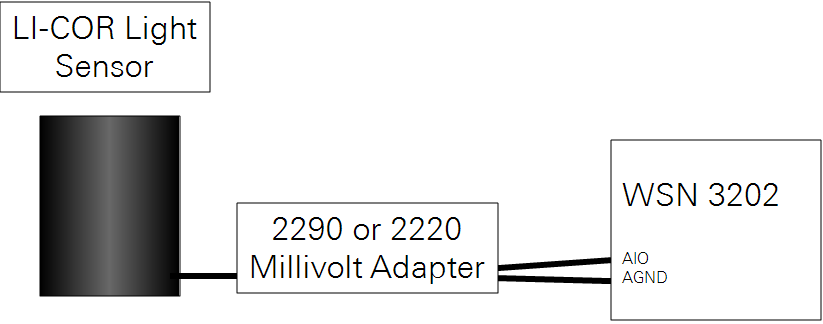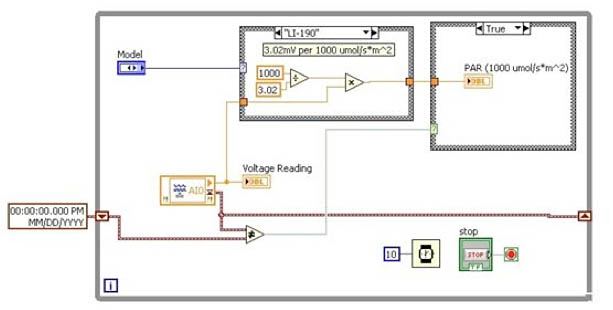Using LI-COR sensors with National Instruments wireless sensor networks
This document describes the use of LI-COR light sensors with the National Instruments (NI) Wireless Sensor Networks (WSN) system for wireless measurements of light radiation.
LI-COR light sensors use a silicon photodiode to translate light energy to current. When a photon of light with sufficient energy strikes the photodiode, it excites an electron, which in turn generates a microampere current as a result of the incident light on the photodiode's surface. LI-COR offers various light sensors which differ in the spectral response they have to different levels of light excitation, depending on what they are specifically meant to measure.
Light
In many applications across industries, light sensors are used to track, measure, and quantify light radiation. Various types of light sensors are used in the field, and can be connected to the NI WSN for completely wireless measurements of light radiation in all of its forms. For this discussion, we will focus on the use of light sensors to measure Photosynthetically Active Radiation (PAR), Global Solar Radiation, and illumination. A good description of the principals of radiation measurement is available at licor.app.boxenterprise.net/s/liuswfuvtqn7e9loxaut.
Photosynthetically Active Radiation (PAR)
PAR is a measurement used to quantify how much energy, due to light from the sun, plants receive during photosynthesis. LI-COR quantum sensors are used to measure such a phenomenon, and quantify PAR in terms of watts per square meter (W/m2) or in terms of quanta (or photons) per time per square meter (). For accurately measuring PAR produced by both natural and artificial lighting, the LI-190R and LI-191R quantum sensors filter out all light frequencies outside of a 400 to 700 nm waveband as this is the active range of waveband that causes photosynthesis in most plants. As the instruction manual for the LI-190R and LI-191R sensors states: The quantum sensor is designed to measure PAR received on a plane surface. The indicated sensor response is selected because it approximates the photosynthetic response of plants for which data are available. A silicon photodiode with an enhanced response in the visible wavelengths is used as the sensor. A visible bandpass interference filter in combination with colored glass filters is mounted in a cosine corrected head.
Typical applications for this type of sensor include greenhouses, plant canopies, and other controlled environment or laboratory conditions for measuring PAR. When measuring PAR under natural and artificial light sources (including the sun), relative errors of measuring PAR with the LI-190R and LI-191R have been calculated to be less than less than 5%.
Global Solar Radiation
In many agricultural, meteorological, and solar energy applications, the measurement of global solar radiation can be useful. For such a measurement a pyranometer sensor can be used to measure global solar radiation in terms of Watts per square meter (W/m2). To measure global solar radiation, the LI-COR LI-200R is often used in an outdoor setting atop buildings, bridges, or anywhere where there are no obstructions in the way for it to sense the global solar radiation outside. The spectral response of the LI-200R does not include the entire solar spectrum, so it must be used in the same lighting conditions as those under which it was calibrated. Therefore, the LI-200R should only be used to measure unobstructed daylight. It should not be used under vegetation, artificial lights, in a greenhouse, or for reflected solar radiation.
Illumination
When interested in measuring the amount of light that a light source provides for interior/industrial, or outdoor settings, measuring the illumination, or the amount of visible light, may be a useful application. In order to measure such a quantity, photometric sensors are used to measure illumination in terms of lux (1 footcandle = 10.764 lux). For measurements of lux, the LI-COR LI-210R can be used indoors or outdoors. Some of the applications for the LI-210R Photometric Sensor include interior and industrial lighting, outdoor illuminance, passive solar energy, architecture and lighting models, illumination engineering, and biological sciences that require illuminance measurements.
Wireless Light Measurement
Light sensors, though used in various settings, are typically deployed in mass quantities when measuring the overall effect light has on a given area indoors or outdoors. This way instead of just receiving information about the light at one point, one can characterize the light and radiation on a large area or at remote locations. When using a deployed array of light sensors in the field, wired measurements can become disorganized and expensive very quickly. Fortunately, the LI-COR light sensors can easily interface with the NI WSN-3202 nodes to easily configure and deploy a distributed, wireless light measurement system.
Connecting the LI-COR Light Sensors to the WSN-3202 Node
LI-COR light sensors are self-powered and generate a low-level micro-ampere current that is proportional to the radiation intensity. In order to measure the output signal from the light sensors, one must convert the low-level micro-ampere current to a voltage signal using a precision shunt resistor. LI-COR offers the 2290 and 2220 millivolt adapters to convert current to voltage for the LI-190R, LI-191R, LI-200R, and LI-210R, using an internal shunt resistor, as seen in the table below.
| Sensor(s) | Adapter |
|---|---|
| LI-190R, LI-191R, LI-210R | 2290 millivolt adapter (604 ohm resistance) |
| LI-200R | 2220 millivolt adapter (147 ohm resistance) |
The millivolt adapters can then be connected directly to an analog input channel for the WSN-3202 analog input node, as shown in Figure 1.

To simplify connecting LI-COR sensors to the WSN-3202 node, LI-COR also offers a millivolt adapter that has a variable resistance, offering a 0-10 mV full scale output.
| Sensor | Standardized Output |
|---|---|
| LI-190R-SMV | 10 mV/2000 micro mol s-1 m-2 |
| LI-191R-SMV | 10 mV/2000 micro mol s-1 m-2 |
| LI-200R-SMV | 10 mV/1000 W m-2 |
| LI-210R-SMV | 10 mV/100 klux |
Programming the wireless sensor network
Using LabVIEW on a Host PC with NI WSN-3202
Configuring a LabVIEW program to work with the LI-COR light sensors is very straightforward. First, you should configure the input range of the WSN-3202 to an input range of ±0.5 V. This can be set in the Data Configuration section of the NI WSN-3202 Properties window, accessed by right-clicking on the node in the LabVIEW Project.
When programming in LabVIEW, you read the input signal on an analog input channel of the WSN-3202 node via a LabVIEW shared variable. This shared variable returns an unscaled voltage value, which must be scaled to the appropriate engineering units. For instance, if using the LI-190R to measure PAR, you can use the LI-190 specifications to see that it outputs 5 micro A per 1000 micro mol s-1 m-2. When used with the 604 ohm millivolt adapter, this corresponds to 3.02 mV per 1000 micro mol s-1 m-2. An example block diagram of a LabVIEW program that takes a reading, scales the reading to degrees, and displays the value on the front panel. Consult your sensor's specifications for proper scaling factors to use.

Using LabVIEW WSN Embedded Programs on the NI WSN-3202
With LabVIEW WSN and the programmable version of the WSN-3202 node, you can download and run LabVIEW VIs on the WSN node for local data processing and control. For example, you could perform the data scaling to engineering units locally on the node, filter the data, program a customized triggering or event detection algorithm, or perform local alarming in the node itself.
